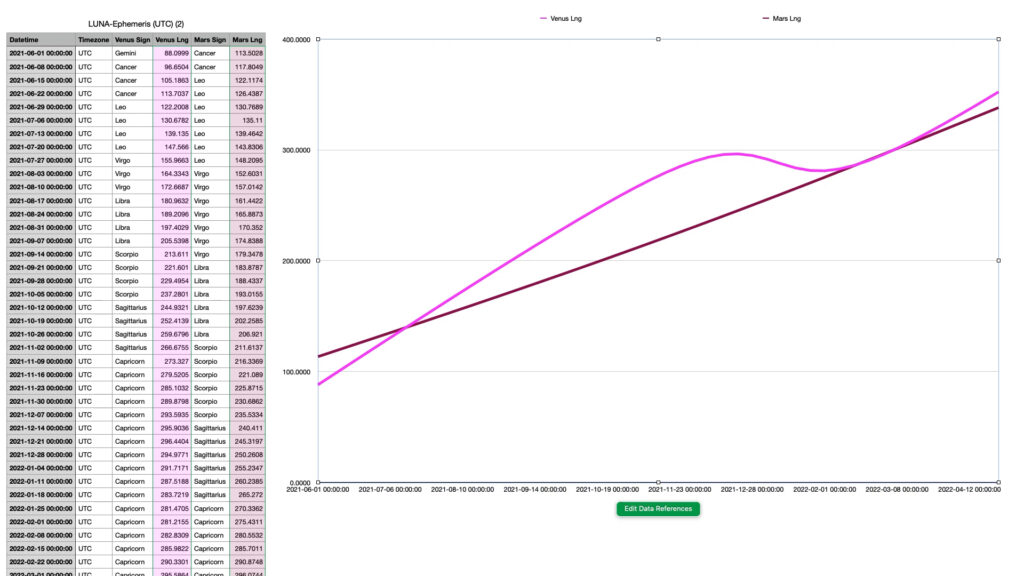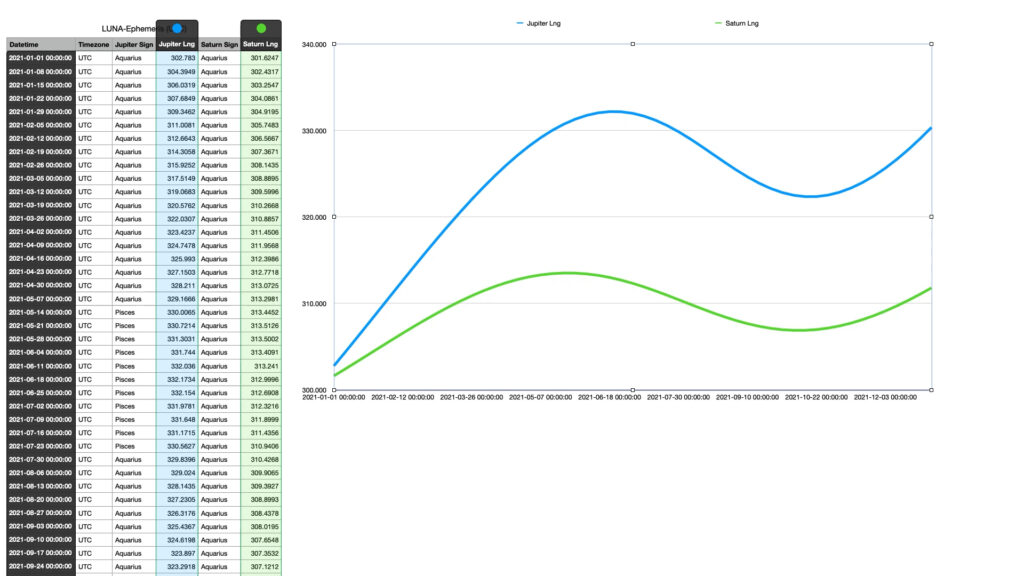An ephemeris is a reference tool for tracking planetary motion and transits. There are a variety of ways an ephemeris can be utilized. With LUNA you can easily generate a custom ephemeris based on the location and time interval parameters you set. Select or deselect chart points, ecliptic and equatorial coordinates and data notation to fit your preferences.
Start by selecting Ephemeris from the DataSheets tab at the top of the screen. On mobile, you can access the Ephemeris by clicking the three vertical dots at the top right corner of the screen.
Customize Location & Interval
By default, the “Set Location” field is based on standard UTC time or Coordinated Universal Time, which is within 1 second of mean solar time without the adjustment of daylight savings time. You can select a specified location/timezone by toggling the drop-down menu option “Localize ephemeris results to a location” and set it to your default location or enter a new location. LUNA adjusts to the local timezone automatically for you into the ephemeris.
The “Set Timeline” fields are preset to start from the current day until the next four weeks at 12:00 am, but this can be overridden. The increments, or interval of time, is also preset to once a day. Adjust to increments of up to 10 and by minute, hour, day, week, month or year. These calculations allow you to observe transits of faster and slower moving planets with better precision.
Calculate Selective Chart Points
Chart Points are pre-selected automatically based on your individual LUNA settings. You can choose to select or deselect these options without effecting your system preferences. LUNA allows you to customize your ephemeris based on the following options:
- Luminaries
- Social Planets
- Transpersonal Planets
- Lunar Nodes (North/South)
- Lunar Apsides (Lilith/Priapus)
- Centaurs
- Asteroids
- Personal Planets
- Hypothetical Bodies
Configure Output Data Points
LUNA offers all coordinates and velocities from each of the coordinate systems as optional output data points. By default, ecliptic longitude and equatorial declination are pre-selected and are standard data points observed by most astrologers. Select velocities to track the movement and directional changes of any chart point. This can be particularly helpful when noting retrograde periods.
Select the data format to display calculation values by zodiacal (degree) notation or decimal notation. Zodiacal notation is pre-selected by default, but decimal notation is recommended if you intend to download the ephemeris as a spreadsheet for Excel or other spreadsheet applications. Decimal notation will allow the application to identify and sort columns accurately, allowing you to create custom graphs and charts.~~~~
Click on “Generate Ephemeris” to create and view your calculations.
View & Download
View your ephemeris based on your custom settings. As you move your cursor, each block of coordinates is highlighted to better aid you in viewing different sets of coordinates. If you need to make adjustments, you can click on the purple description link (“Back” if viewing on mobile) on the upper left side of the screen to return to your preferences. Once you are ready, click on “Download” on the upper right corner (upper left if viewing on mobile) to generate a CSV file. Now you can view the data in any spreadsheet program.

Select this icon from the toolbar to view the Aspects DataSheet for the current chart.
Examples
The following graphs were created using output generated directly from LUNA’s Dynamic Ephemeris. The program used to create these graphs is Apple Numbers, but any spread sheet application can produce the same results.
Notice that viewing ephemeris results in this way can help you visualize significant transit points such as conjunctions and retrogrades.
Path of Venus & Mars
From June 1, 2021 – April 30, 2022

Click or tap the image to view a larger version.
Path of Jupiter & Saturn
From January 1, 2021 – September 30, 2021

Click or tap the image to view a larger version.
